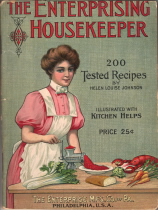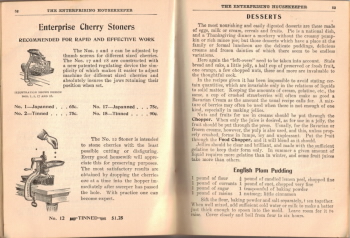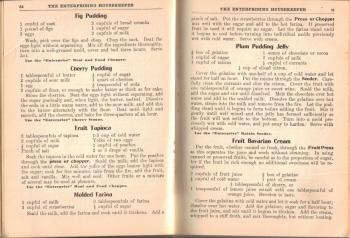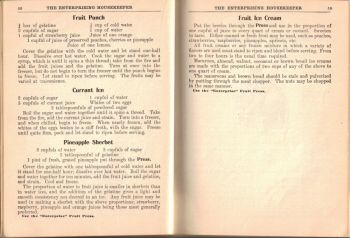 Here are pages 52, 53, 54, 55, 56, 57, 58 and 59 from the vintage booklet The Enterprising Housekeeper from the sixth edition (1906).
Here are pages 52, 53, 54, 55, 56, 57, 58 and 59 from the vintage booklet The Enterprising Housekeeper from the sixth edition (1906).
Desserts
The most nourishing and easily digested desserts are those made of eggs, milk or cream, cereals and fruits. Pie is a national dish, and a Thanksgiving dinner a mockery without the creamy pumpkin or rich mince pie; but those desserts which have a place at the family or formal luncheon are the delicate puddings, delicious creams and frozen dainties of which there seem to be endless variations.
Here again the “left-overs” need to be taken into account. Stale bread and cake, a little jelly, a half cup of preserved or fresh fruit, one orange, a few chopped nuts, these and more are invaluable to the thoughtful cook.
In the recipes given it has been impossible to avoid stating certain quantities, which are invariable only in the relations of liquids to solid matter. Keeping the amounts of cream, gelatine, etc., the same, a cup of crushed strawberries will often make as good a Bavarian Cream as the amount the usual recipe calls for. A mixture of berries may often be used when there is not enough of one kind, especially in making jellies.
Nuts and fruits for use in creams should be put through the Chopper. When only the juice is desired, as for use in a jelly, the fruit should be put through the press. Usually, for the Bavarian or frozen creams, however, the pulp is also used, and this, unless properly crushed, forms in lumps, icy and unpleasant. Put the fruit through the Food Chopper, and it will blend as it should.
Jellies should be clear and brilliant, and made with the sufficient gelatine to keep their form only. In summer a given amount of liquid requires more gelatine than in winter, and some fruit juices take more than others.
English Plum Pudding
1 pound of flour
1 pound of currants
1 pound of sugar
1 pound of raisins
1/4 pound of candied lemon peel, chopped fine
1 pound of suet, chopped very fine
1 teaspoonful of baking powder
1 nutmeg; little cinnamon
Sift the flour, baking powder and salt separately, then together. When well mixed, add sufficient cold water or milk to make a batter just thick enough to spoon into the mold. Leave room for it to raise. Cover closely and boil from four to six hours.
Fig Pudding
1 cupful of suet
1 pound of figs
3 eggs
2 cupfuls of bread crumbs
1 cupful of sugar
2 cupfuls of milk
Wash, pick over the figs and chop. Chop the suet. Beat the eggs light without separating. Mix all the ingredients thoroughly, turn into a well-greased mold, cover and boil three hours. Serve hot.
Cherry Pudding
1 tablespoonful of butter
2 cupfuls of sour milk
1 egg
1/2 cupful of sugar
1 quart of cherries
1/2 teaspoonful of soda
2 cupfuls of flour, or enough to make batter as thick as for cake.
Stone the cherries. Beat the eggs light without separating, add the sugar gradually and, when light, the butter, melted. Dissolve the soda in a little warm water, add to the sour milk, and add this to the batter alternately with the flour. Beat until light and smooth, add the cherries, and bake for three-quarters of an hour.
Fruit Tapioca
2 tablespoonfuls of tapioca
2 cupfuls of milk
1/2 cupful of sugar
Pinch of salt
1-3 cup of cold water
Yolks of two eggs
1 cupful of peaches
2 or 3 drops of vanilla
Soak the tapioca in the cold water for one hour. Put the peaches through the press or chopper. Scald the milk, add the tapioca and cook until clear. Add the yolks of the eggs beaten light with the sugar; cook for five minutes, take from the fire, add the fruit, salt and vanilla. Mix well and cool. Other fruits or a mixture of several may be used at pleasure.
Molded Farina
1 cupful of milk
1 cupful of strawberries
3 tablespoonfuls of farina
1/2 cupful of sugar
Scald the milk, add the farina and cook until it thickens. Add a pinch of salt. Put the strawberries through the Press or Chopper, mix well with the sugar and add to the hot farina. If preserved fruit be used it will require no sugar. Let the farina stand until it begins to cool before turning into individual molds previously wet with cold water. Serve with cream.
Plum Pudding Jelly
1/2 box of gelatine
1 cupful of sugar
1 cupful of raisins
1 ounce of chocolate or cocoa
2 cupfuls of milk
1/4 cupful of currants
1/4 cup of sliced citron.
Cover the gelatine with one-half of a cup of cold water and let stand for half an hour. Put the raisins through the Seeder. Carefully clean the currants and slice the citron. Cover the fruit with one tablespoonful of orange juice or sweet wine. Scald the milk, add the sugar and stir until dissolved. Melt the chocolate over hot water and add to the scalded milk. Dissolve the gelatine over hot water, strain into the milk and remove from the fire. Let the pudding stand until it begins to form before adding the fruit. Stir it gently until well mixed and the jelly has formed sufficiently so the fruit will not settle to the bottom. Turn into a mold previously wet with cold water, and put away to harden. Serve with whipped cream.
Fruit Bavarian Cream
Put the fruit, whether canned or fresh, through the Fruit Press as this separates the juice and seeds without straining. In using canned or preserved fruits, be careful as to the proportion of sugar, for if the fruit be rich enough no additional sweetness will be required.
2 cupfuls of fruit juice
1/2 cupful of cold water
1/2 box of gelatine
1 pint of cream
1 tablespoonful of sherry, or 1 teaspoonful of lemon juice mixed with one tablespoonful of orange juice. Sweeten to taste.
Cover the gelatine with cold water and let it soak for a half hour; dissolve over hot water. Add the gelatine, sugar and flavoring to the fruit juice, and stir until it begins to thicken. Add the cream, whipped to a stiff froth, and mix thoroughly, but without beating.
Turn into a mold previously wet with cold water, and put away to harden before serving.
If the fruit juice be added to the cream before it has begun to thicken it is almost impossible to keep it from settling. Strawberries, raspberries, pineapples, peaches, apricots and oranges are the fruits generally used.
Lemon Jelly
1/2 box of gelatine
2 cupfuls of boiling water
1/2 cupful of lemon juice
1/2 cup of cold water
1 cupful of sugar
1 tablespoonful of sherry
1/4 cupful of orange juice
Cover the gelatine with cold water and let it stand for half an hour. Pour over it the boiling water, add the sugar and stir until the gelatine and sugar are dissolved. Add the lemon and orange juice and the wine; strain through a cloth or filter paper, if necessary. Turn into a mold previously wet with cold water and put away to harden.
In making gelatine jellies a blending of flavors is usually more acceptable than to use a single one. A wine jelly should have orange and lemon juice in its composition, the flavor of the wine predominating. In orange jelly, the orange flavor should be strongest, and so on.
Strawberry, raspberry, sherry, pineapple and quince jelly all can be made from the above recipe, modifying the amount of ingredients accordingly. Cherries and pineapple will take more gelatine and no lemon juice, or the jelly will be too acid. Strawberries need a teaspoonful of lemon juice only, raspberries and quinces require two.
Russian Jelly
1/2 cupful of canned or preserved fruit or berries
1/2 box of gelatine
1 cupful of boiling water
1/4 cup of lemon juice
2 tablespoonfuls of wine
1/2 cup of cold water
1 1/2 cupfuls of sugar
1/2 cup of orange juice
Put the berries, if fresh, through the Press, and cover with one-half cup of sugar. Cover the gelatine with the cold water and let it stand one-half hour. Add the boiling water, and when the gelatine is dissolved, add the sugar, fruit juices and wine. As soon as the jelly begins to harden, whip with a wire beater until the whole mass is frothy like snow pudding. Put away in mold previously wet with cold water, to harden.
Frozen Pudding
1 cupful of milk
Yolk of one egg
1 1/2 cupfuls of sugar
1 cupful of preserved fruit
1 teaspoonful of vanilla
1 pint of cream
1 tablespoonful of cornstarch
1 cupful of raisins
1/4 cup of chopped nuts
Pinch of salt
Scald the milk, add the sugar and stir until dissolved. Mix the cornstarch with a little cold milk and add with the beaten yolk of the egg to the scalded milk. Cook fully three-quarters of an hour, stirring occasionally. Take from the fire, add the tiniest pinch of salt, the vanilla, fruit and nuts. When cold, add the cream, whipped, and freeze.
This recipe may be varied at will by the use of different fruits and nuts, addition of citron, and the use of various flavors. Gelatine, one-half of a box, may be used in place of the cornstarch, and the pudding left to mold instead of being frozen.
Frozen Macedonia
1 cupful of canned or preserved pears
1 cupful of canned or preserved plums
1 cupful of canned or preserved cherries
1 cupful of canned or preserved pineapple
Drain the juice from the cherries; put the other fruits through the Fruit Press, and add the cherry juice. Sweeten to taste. If all preserved fruits are used no more sugar will be needed, but add one-fourth of a cup of cold water with two teaspoonfuls of lemon juice. The addition of the water and lemon juice are needed to balance the extreme sweetness of the preserved fruits, so sugar, water and lemon juice must be added to taste in accordance with the fruits used.
Freeze the juice or pulp, and when nearly frozen beat in the cherries. Pack and let stand at least an hour, longer would be better, before serving.
Fruit Punch
1/4 box of gelatine
2 cupfuls of sugar
1 cupful of strawberry juice
1/4 cup of cold water
1 cup of water
Juice of one orange
1 cupful of juice of preserved peaches, cherries or pineapple
Juice of one lemon.
Cover the gelatine with cold water and let stand one-half hour. Dissolve over hot water. Cook the sugar and water to a syrup, which is until it spins a thin thread; take from the fire and add the fruit juices and the gelatine. Turn at once into the freezer, but do not begin to turn the freezer until the punch begins to freeze. Let stand to ripen before serving. The fruits may be varied at convenience.
Currant Ice
2 cupfuls of sugar
3 cupfuls of currant juice
1 cupful of water
Whites of two eggs
2 tablespoonfuls of powdered sugar
Boil the sugar and water together until it spins a thread. Take from the fire, add the currant juice and strain. Turn into a freezer, and when chilled, begin to freeze. When nearly frozen, add the whites of the eggs beaten to a stiff froth, with the sugar. Freeze until quite firm, pack and let stand to ripen before serving.
Pineapple Sherbet
2 cupfuls of water
2 cupfuls of sugar
1 tablespoonful of gelatine
1 pint of fresh, grated pineapple put through the Press.
Cover the gelatine with one tablespoonful of cold water and let it stand for one-half hour; dissolve over hot water. Boil the sugar and water together for ten minutes, add the fruit juice and gelatine, and strain. Cool and freeze.
The proportion of water to fruit juice is smaller in sherbets than in water ices, and the addition of the gelatine gives a light and smooth consistency not desired in an ice. Any fruit juice may be used in making a sherbet with the above proportions; strawberry, raspberry, pineapple and orange juices being those most generally preferred.
Fruit Ice Cream
Put the berries through the Press and use in the proportion of one cupful of juice to every quart of cream or custard. Sweeten to taste. Either canned or fresh fruit may be used, such as peaches, strawberries, raspberries, pineapples, apricots, etc.
All fruit creams or any frozen mixture in which a variety of flavors are used must stand to ripen and blend before serving. From two to four hours is the usual time required.
Macaroon, almond, walnut, cocoanut or brown bread ice creams are made with the proportions of two cups of any of the above to one quart of cream.
The macaroons and brown bread should be stale and pulverized by putting through the meat chopper. The nuts may be chopped in the same manner.
 More Recipes For You To Enjoy:
More Recipes For You To Enjoy:







